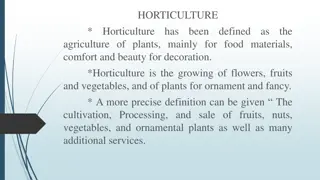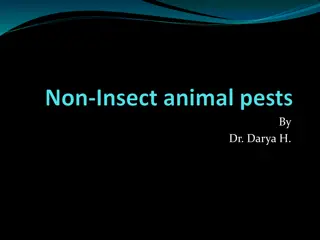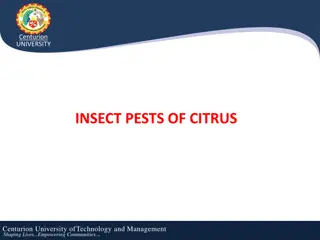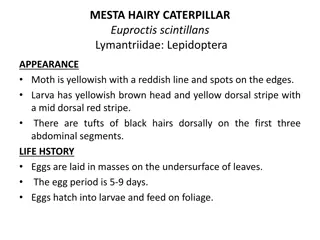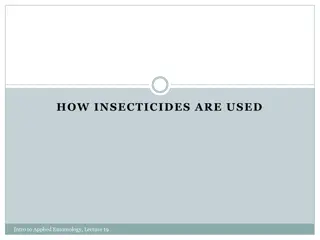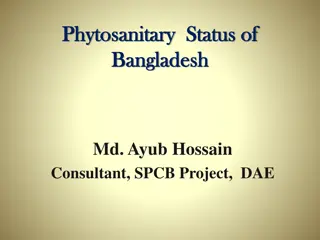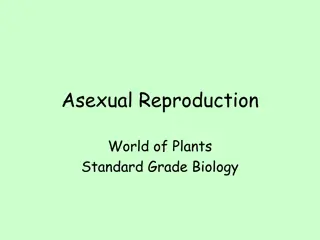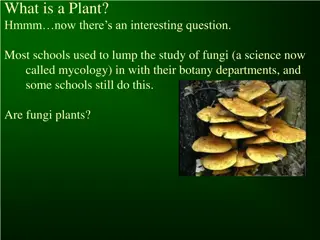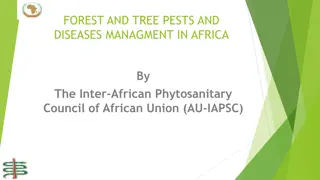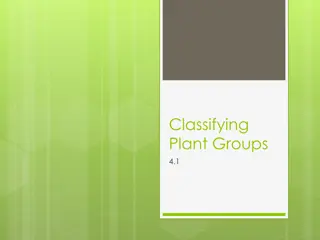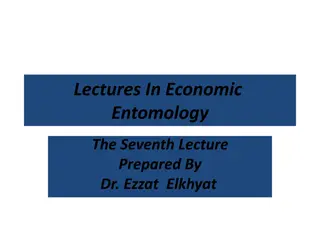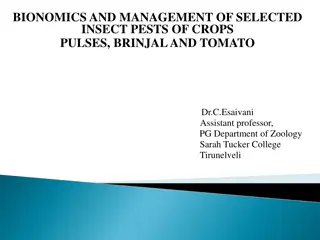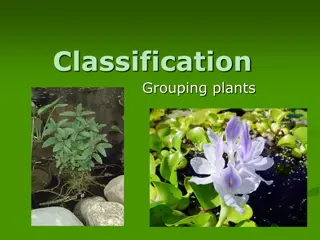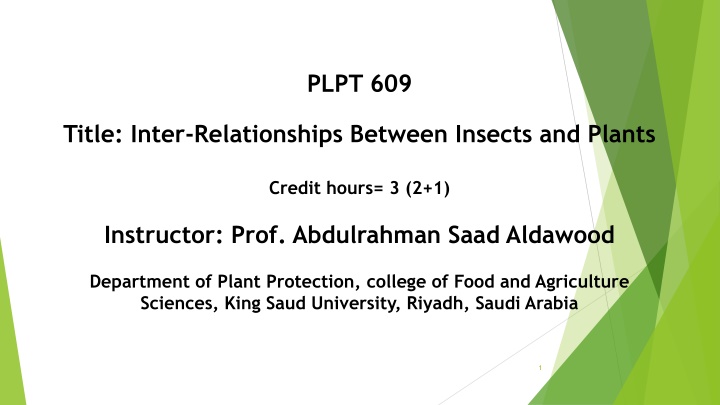
Inter-Relationships Between Insects and Plants: Allelochemical Interactions and Phytochemical Roles
Explore the intricate connections between insects and plants, focusing on allelochemical interactions and the role of phytochemicals in insect behavior. Discover how plants and pests communicate through chemical cues, influencing oviposition and host selection. Delve into rare plant-insect relationships and the impact of plant stress on insect interactions.
Download Presentation

Please find below an Image/Link to download the presentation.
The content on the website is provided AS IS for your information and personal use only. It may not be sold, licensed, or shared on other websites without obtaining consent from the author. If you encounter any issues during the download, it is possible that the publisher has removed the file from their server.
You are allowed to download the files provided on this website for personal or commercial use, subject to the condition that they are used lawfully. All files are the property of their respective owners.
The content on the website is provided AS IS for your information and personal use only. It may not be sold, licensed, or shared on other websites without obtaining consent from the author.
E N D
Presentation Transcript
PLPT 609 Title: Inter-Relationships Between Insects and Plants Credit hours= 3 (2+1) Instructor: Prof. Abdulrahman Saad Aldawood Department of Plant Protection, college of Food and Agriculture Sciences, King Saud University, Riyadh, Saudi Arabia 1
Contents Allelochemicals interactions among plants Herbivores and their predators Allelochemicals reflecting interactions between plants and pests Role of plant allelochemicals in the survival strategy of herbivores Rare plant-insect relationships Plant stress and Insect interactions 2
Allelochemicals reflecting interactions between plants and pests o Majority of insects are herbivores which depends on plants for their nutrients. o Allelochemicals have significant effects on insect plant interactions. o Secondary metabolites, play important roles in many types of insect behaviors and can even regulate their growth and reproduction. o The abilities of insects to counteract the plants allow them to make use of certain phytochemicals as cues to locate and recognize suitable food or host plants. o Various attractants, stimulants, repellents, and deterrents are usually involved in this process. 3 Hori and Kainoh 2013
Allelochemicals reflecting interactions between plants and pests Phytochemicals Involved in Oviposition o Host selection by insects are influenced by the chemical constituents present in the plants. o Plant chemicals serve as oviposition stimulants or deterrents for many lepidopterans and other insects. o The North American black swallowtail butterfly, Papilio polyxenes, a specialist on members of carrot family (Apiaceae), lay eggs in response to a mixture of two chemotactile stimulants, luteolin 7-O-(600-O- malonyl)-b-D-glucoside and trans-chlorogenic acid, identified from one of its major host plants, Daucus carota(wild carrot). 4 Carter et al 1998
Allelochemicals reflecting interactions between plants and pests Phytochemicals Involved in Oviposition-conti--- o The diamondback moth, Plutella xylostella (Plutellidae), has previously been shown to lay eggs in response to diverse glucosinolates (sinigrin, etc.) present in crucifers, synergized by leaf epicuticular waxes. o More recently, 4-methoxyglucobrassicin (4-methoxy-indol-3- ylmethylglucosinolate), present in Arabidopsis thaliana, has been identified as a strong oviposition stimulant for the moth. 5 Sun et al., 2009
Allelochemicals reflecting interactions between plants and pests Phytochemicals Involved in Oviposition-conti--- o The European corn borer, Ostrinia nubilalis (Crambidae), is a highly polyphagous moth, which attacks several major crops including maize, tomato, and cotton. o Each of the n-alkanes (C26 C29) and tritriacontane (C33) present in the leaf epicuticular wax of corn, Zea mays, was shown to be responsible for eliciting oviposition on the plant. 6 Find more examples of allelochemicals which are involved in oviposition? Udayagiri et al., 1997
Allelochemicals reflecting interactions between plants and pests Phytochemicals as Feeding Attractants and Stimulants o Many coleopteran beetles use host-plant volatiles for host location. o Strawberry leaf beetle, Galerucella vittaticollis (Crysomelidae),feeds on polygonaceous plant leaves and also on strawberry leaves, Fragaria ananassa (Rosaceae). o The main component of both polygonaceous plant and strawberry leaf volatiles is the compound, (Z)-3-hexenyl acetate. (Z)-3-Hexenyl acetate attracts G. vittaticollis at concentrations of 0.01 0.05%. 7 Hori et al., 2006
Allelochemicals reflecting interactions between plants and pests Phytochemicals as Feeding Attractants and Stimulants-conti--- o The Japanese beetle, Popillia japonica (Scarabaeidae), is a polyphagous insect feeding on the fruit, flowers, or foliage of about 300 species of plants. o It is attracted to many naturally occurring plant volatiles, including phenylacetonitrile, (Z)-3-hexenyl benzoate, nerolidol, (Z)-3-hexenyl hexanoate, (Z)-3-hexenyl 2-methylbutyrate, ( )-limonene, and ( )-a-pinene, 8 Loughrin et al., 1998
Allelochemicals reflecting interactions between plants and pests Phytochemicals as Feeding Attractants and Stimulants-conti--- Sixteen ester compounds ethyl acetate, propionate, propyl acetate, methyl butyrate, isobutyrate, propyl acetate, isovalerate, ethyl butyrate, butyl acetate, methylbutyrate, isovalerate, isoamyl acetate, 2-methylbutyl propyl butyrate, propionate butyrate o The strawberry sap beetle, Stelidota geminata (Nitidulidae), is also a pest of berries. ethyl ethyl o Both adults and larvae feed on ripe and overripe fruits of strawberry, blueberry, raspberry, cherry, peach, melon, etc. 2-methyl methyl ethyl 2 ethyl o Strawberry headspace contained sixteen ester compounds which evoke antennal responses in adult female beetles. acetate, butyl hexyl and o The beetles are strongly attracted to strawberry odor. 9 Loughrin et al., 1998
Allelochemicals reflecting interactions between plants and pests Phytochemicals as Feeding Attractants and Stimulants-conti--- o Plant volatiles also act synergistically with aggregation pheromones. o Aggregation of the American palm weevil, Rhynchophorus palmarum (Curculionidae), on host plants is mediated by host-plant volatiles and a male pheromone (rhynchophorol). o Acetoin, one of the major volatile components of the host plants Cocos nucifera (Arecaceae), Saccharumofficinarum (Poaceae), Jacaratia spp. (Caricaceae), and Elaeis spp. (Arecaceae), plays an important role in the aggregation of weevils on these plants. 10 Find more examples of allelochemicals which act as a feeding attractants ? Sa d et al., 2005
Allelochemicals reflecting interactions between plants and pests Phytochemicals as Feeding Attractants and Stimulants-conti--- Floral Volatiles o Many species of insects visit flowers to acquire nutrition and coincidentally contribute to pollination. o The scents, as well as the colors, of flowers serve as primary cues for mediating the long-range attraction of insects. o More than 1700 compounds from around 1000 plant species have been identified as floral volatiles. o Honeybees, butterflies, and moths preferentially respond to linalool, benzaldehyde, and/or phenylacetaldehyde contained in the floral scents of various plants. Find more examples of floral scents which act as a feeding attractants ? 11 Wright et al., 2005; Knudsen et al., 2006; Raguso et al., 2006
Allelochemicals reflecting interactions between plants and pests Phytochemicals role as Insect-Plant Interface in Multitrophic Interactions o As a response to feeding damage by insect herbivores plants emit various volatiles called herbivore-induced plant volatiles (HIPVs). o Natural enemies of these herbivores, (parasitoids and predators), use these HIPVs to locate the plant on which the hosts or prey are feeding. o Release of HIPVs occurs a few hours after the initial damage and is not limited to the feeding site but can systemically occur from the whole plant, so even undamaged leaves of a damaged plant release volatiles. Find more examples of allelochemicals which act as a feeding attractants ? o In this way, plants indirectly attract natural enemies to defend themselves. 12 Turlings et al., 1992; Hilker & Meiners, 2006
Allelochemicals reflecting interactions between plants and pests HIPVs role as Insect-Plant Interface in Multitrophic Interactions-Conti--- Predators o Few studies have been reported on the attraction of predators to prey- infested plants. o The predatory mite Phytoseiulus persimilis was first reported to be attracted to volatiles from lima bean leaves infested with the two- spotted spider mite Tetranychus urticae. o Those prey-induced volatiles were identified as linalool, methyl salicylate (53), (E)- -ocimene and DMNT, all were attractive to P. persimilis. Find more examples of HIPVs which attracts predators? 13 Sabelis et al., 1983; Dicke et al., 1990
Allelochemicals reflecting interactions between plants and pests HIPVs role as Insect-Plant Interface in Multitrophic Interactions-Conti--- Parasitic Wasps o A number of hymenopteran parasitoids are attracted to herbivore- infested plants that emit HIPVs. o Cotesia marginiventris (Hymenoptera: Braconidae) is responsive to HIPVs from corn seedlings damaged by Spodoptera exigua. o Cotesia kariyai, braconid parasitoid of the common armyworm Mythimna separata (Lepidoptera: Noctuidae). The female wasp uses chemical cues from the host and host-plant complex to find their hosts. Find more examples of HIPVs which attracts parasitic wasps? 14 Turlings et al., 1990; Takabayashi et al., 1995
Allelochemicals reflecting interactions between plants and pests HIPVs role as Insect-Plant Interface in Multitrophic Interactions-Conti--- Parasitic Flies o The parasitic fly, Exorista japonica (Diptera: Tachinidae), is a gregarious and polyphagous parasitoid that attacks a number of lepidopteran pests, particularly noctuid larvae. o When corn plants infested with final instar larvae of common armyworm Mythimna separata, the plants release a blend of HIPVs. o The odors of HIPVs attract E. japonica females that lay eggs on last instar host larvae Find more examples of HIPVs which attracts parasitic flies? 15 Ichiki et al., 2011
Allelochemicals reflecting interactions between plants and pests HIPVs role as Insect-Plant Interface in Multitrophic Interactions-Conti--- Elicitors Elicitors are compounds stimulating any type of plant defense. o Feeding by herbivorous insects results in mechanical damage and adhesion of regurgitant to the wounded leaves, which cause the emission of HIPVs from the plant. o The regurgitant contains an elicitor that induces plant defenses. o -glucosidase was isolated and identified as an elicitor from Pieris braccicae larvae that causes the release of volatiles from Brassica plants. 16 Mattiacci et al., 1995
Conclusion The chemicals produced by plants and insects can have significant effects on their lives. Phytochemicals, particularly secondary metabolites, play important and often crucial roles in many types of insect behaviors, and can even regulate their growth and reproduction. The abilities of insects to counteract the plants chemical barriers, allow them to make use of certain phytochemicals as cues to locate and recognize suitable food or host plants. HIPVs areof great importance from the perspective of future agriculture as the need to develop environmentally benign pest control. 17
References Hori, M., & Kainoh, Y. 2013. Allelochemicals in Plant Insect Interactions. Carter, M., Sachdev-Gupta, K., & Feeny, P. (1998). Tyramine isolated from parsnip leaves: A stimulant and synergist for oviposition of the black swallowtail. Physiol. Entomol., 23, 303-312. Sun, J. Y., S nderby, I. E., Halkier, B. A., Jander, G., & de Vos, M. (2009). Non-volatile intact indole glucosinolates are host recognition cues for ovipositing Plutella xylostella. Journal of chemical ecology, 35, 1427-1436. Udayagiri, S., & Mason, C. E. (1997). Epicuticular wax chemicals in Zea mays influence oviposition in Ostrinia nubilalis. Journal of Chemical Ecology, 23, 1675-1687. Hori, M., Ohuchi, K., & Matsuda, K. (2006). Role of host plant volatile in the host-finding behavior of the strawberry leaf beetle, Galerucella vittaticollis Baly (Coleoptera: Chrysomelidae). Applied entomology and zoology, 41(2), 357-363. Loughrin, J. H., Potter, D. A., & Hamilton-Kemp, T. R. (1998). Attraction of Japanese beetles (Coleoptera: Scarabaeidae) to host plant volatiles in field trapping experiments. Environmental entomology, 27(2), 395-400. Sa d, I., Renou, M., Morin, J. P., Ferreira, J. M., & Rochat, D. (2005). Interactions between acetoin, a plant volatile, and pheromone in Rhynchophorus palmarum: Behavioral and olfactory neuron responses. Journal of Chemical Ecology, 31, 1789-1805. Raguso, R. A. Behavioral Responses to Floral Scent: Experimental Manipulations and the Interplay of Sensory Modalities. In Biology of Floral Scent; Dudareva, N.; Pichersky, E., Eds.; CRC Press: Boca Raton, 2006; pp 297 318, Chapter 13. Knudsen, J. T., Eriksson, R., Gershenzon, J., & St hl, B. (2006). Diversity and distribution of floral scent. The botanical review, 72(1), 1-120. 18
References-conti-- Wright, G. A., Lutmerding, A., Dudareva, N., & Smith, B. H. (2005). Intensity and the ratios of compounds in the scent of snapdragon flowers affect scent discrimination by honeybees (Apis mellifera). Journal of Comparative Physiology A, 191, 105-114. Hilker, M., & Meiners, T. (2006). Early herbivore alert: insect eggs induce plant defense. Journal of chemical ecology, 32, 1379-1397. Turlings, T. C., & Tumlinson, J. H. (1992). Systemic release of chemical signals by herbivore-injured corn. Proceedings of the National Academy of Sciences, 89(17), 8399-8402. Turlings, T. C., Tumlinson, J. H., & Lewis, W. J. (1990). Exploitation of herbivore-induced plant odors by host- seeking parasitic wasps. Science, 250(4985), 1251-1253. Takabayashi, J., Takahashi, S., Dicke, M., & Posthumus, M. A. (1995). Developmental stage of herbivore Pseudaletia separata affects production of herbivore-induced synomone by corn plants. Journal of Chemical Ecology, 21, 273-287. Ichiki, R. T., Kainoh, Y., Yamawaki, Y., & Nakamura, S. (2011). The parasitoid fly Exorista japonica uses visual and olfactory cues to locate herbivore infested plants. Entomologia Experimentalis et Applicata, 138(3), 175-183. Sabelis, M. W., & Van de Baan, H. E. (1983). Location of distant spider mite colonies by phytoseiid predators: demonstration of specific kairomones emitted by Tetranychus urticae and Panonychus ulmi. Entomologia experimentalis et applicata, 33(3), 303-314. Dicke, M., Van Beek, T. A., Posthumus, M. A., Ben Dom, N., Van Bokhoven, H., & De Groot, A. E. (1990). Isolation and identification of volatile kairomone that affects acarine predatorprey interactions Involvement of host plant in its production. Journal of chemical ecology, 16, 381-396. Mattiacci, L., Dicke, M., & Posthumus, M. A. (1995). beta-Glucosidase: an elicitor of herbivore-induced plant odor that attracts host-searching parasitic wasps. Proceedings of the National Academy of Sciences, 92(6), 2036-2040 19



